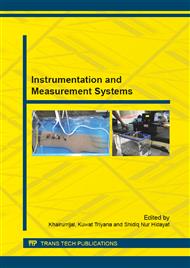p.125
p.129
p.133
p.137
p.141
p.145
p.149
p.157
p.161
Photodynamic Combined with Magnetic Field Applications for Viability Activation of Anaerobic Photosynthetic Bacteria
Abstract:
This paper reports the influence of light exposure (photodynamic) and magnetic field application on viability activation of anaerobic photosynthetic bacteria (rhodobacter sphaeroides). For photosynthetic process, the rhodobacter sphaeroides have bacteriochlorophyll and carotenoid as major and accessory pigments, respectively. A customized equipment was developed for investigating the effect of light and magnetic field applications on the growth of the bacterial colonies. It was consisted of three main parts, namely a sample holder, an array of light emitting diode (LED) as light source and Helmholtz coils as magnetic field source. The systems of this equipment were controlled by a microntroller of AVR ATMega-8535. Prior to the application in vitro, all LEDs were calibrated, both their intensity and wavelength. After the treatments, all bacteria substances were grown in photosynthetic media (PMS) for 48 hours followed by calculating the number bacterial colonies growth using a total plate count (TPC) method and Quebec colony counter. It was found that the growths of bacterial colonies were influenced by both light intensity and wavelength of LED array. At the same intensities, the wavelength of 430 nm showed highest effect on the growth of bacterial colonies. In addition, upon application of the optimum light combined with magnetic field, the highest growth of bacterial colonies was achieved more than 110% when the optimized light source of energy dose was 204 J/cm2 and magnetic field was 1.8 mT.
Info:
Periodical:
Pages:
141-144
Citation:
Online since:
July 2015
Authors:
Price:
Сopyright:
© 2015 Trans Tech Publications Ltd. All Rights Reserved
Share:
Citation:


